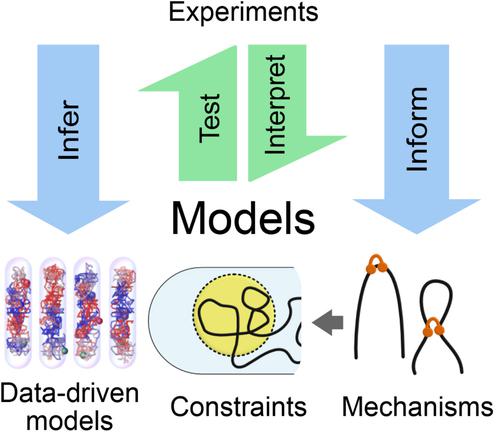当前位置:
X-MOL 学术
›
Mol. Microbiol.
›
论文详情
Our official English website, www.x-mol.net, welcomes your feedback! (Note: you will need to create a separate account there.)
Physical models of bacterial chromosomes
Molecular Microbiology ( IF 3.6 ) Pub Date : 2024-04-05 , DOI: 10.1111/mmi.15257 Janni Harju 1 , Chase P. Broedersz 1, 2
Molecular Microbiology ( IF 3.6 ) Pub Date : 2024-04-05 , DOI: 10.1111/mmi.15257 Janni Harju 1 , Chase P. Broedersz 1, 2
Affiliation

|
The interplay between bacterial chromosome organization and functions such as transcription and replication can be studied in increasing detail using novel experimental techniques. Interpreting the resulting quantitative data, however, can be theoretically challenging. In this minireview, we discuss how connecting experimental observations to biophysical theory and modeling can give rise to new insights on bacterial chromosome organization. We consider three flavors of models of increasing complexity: simple polymer models that explore how physical constraints, such as confinement or plectoneme branching, can affect bacterial chromosome organization; bottom‐up mechanistic models that connect these constraints to their underlying causes, for instance, chromosome compaction to macromolecular crowding, or supercoiling to transcription; and finally, data‐driven methods for inferring interpretable and quantitative models directly from complex experimental data. Using recent examples, we discuss how biophysical models can both deepen our understanding of how bacterial chromosomes are structured and give rise to novel predictions about bacterial chromosome organization.
中文翻译:

细菌染色体的物理模型
使用新颖的实验技术可以更详细地研究细菌染色体组织与转录和复制等功能之间的相互作用。然而,解释由此产生的定量数据在理论上可能具有挑战性。在这篇小综述中,我们讨论了如何将实验观察与生物物理理论和建模联系起来,从而产生关于细菌染色体组织的新见解。我们考虑了三种日益复杂的模型:简单的聚合物模型,探索物理约束(例如限制或皮线分支)如何影响细菌染色体组织;自下而上的机制模型,将这些约束与其根本原因联系起来,例如,染色体压缩与大分子拥挤,或超螺旋与转录;最后,数据驱动的方法直接从复杂的实验数据推断可解释的定量模型。使用最近的例子,我们讨论生物物理模型如何既加深我们对细菌染色体结构的理解,又如何产生关于细菌染色体组织的新预测。
更新日期:2024-04-05
中文翻译:

细菌染色体的物理模型
使用新颖的实验技术可以更详细地研究细菌染色体组织与转录和复制等功能之间的相互作用。然而,解释由此产生的定量数据在理论上可能具有挑战性。在这篇小综述中,我们讨论了如何将实验观察与生物物理理论和建模联系起来,从而产生关于细菌染色体组织的新见解。我们考虑了三种日益复杂的模型:简单的聚合物模型,探索物理约束(例如限制或皮线分支)如何影响细菌染色体组织;自下而上的机制模型,将这些约束与其根本原因联系起来,例如,染色体压缩与大分子拥挤,或超螺旋与转录;最后,数据驱动的方法直接从复杂的实验数据推断可解释的定量模型。使用最近的例子,我们讨论生物物理模型如何既加深我们对细菌染色体结构的理解,又如何产生关于细菌染色体组织的新预测。



























 京公网安备 11010802027423号
京公网安备 11010802027423号